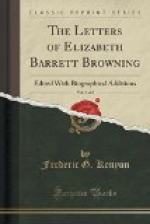The ‘Poems’ of 1844—Miss Martineau and Mesmerism—Pro-posed Journey to Italy
Chapter V
1846-1849
Friendship with Robert Browning—Love and Marriage—Paris and Pisa—Florence—Vallombrosa—Casa Guidi—Italian Politics in 1848
Chapter vi
1849-1851
Birth of a Son—Death of Mrs. Browning,
senior—Bagni di
Lucca—New Edition of Poems—Siena—Florentine
Life
Portrait of Elizabeth Barrett Browning. Frontispiece Casa Guidi
The letters
of
Elizabeth Barrett Browning
CHAPTER I
1806-1835
Elizabeth Barrett Barrett, still better known to the world as Elizabeth Barrett Browning, was born on March 6, 1806, the eldest child of Edward and Mary Moulton Barrett. I Both the date and place of her birth have been matters of uncertainty and dispute, and even so trustworthy an authority as the ‘Dictionary of National Biography’ is inaccurate with respect to them. All doubt has, however, been set at rest by the discovery of the entry of her birth in the parish register of Kelloe Church, in the county of Durham.[2] She was born at Coxhoe Hall, the residence of Mr. Barrett’s only brother, Samuel, about five miles south of the city of Durham. Her father, whose name was originally Edward Barrett Moulton, had assumed the additional surname of Barrett on the death of his maternal grandfather, to whose estates in Jamaica he was the heir. Of Mr. Barrett it is recorded by Mr. Browning, in the notes prefixed by him to the collected edition of his wife’s poems, that ’on the early death of his father he was brought from Jamaica to England when a very young child, as a ward of the late Chief Baron Lord Abinger, then Mr. Scarlett, whom he frequently accompanied in his post-chaise when on circuit. He was sent to Harrow, but received there so savage a punishment for a supposed offence (burning the toast)’—which, indeed, has been a ‘supposed offence’ at other schools than Harrow—’by the youth whose fag he had become, that he was withdrawn from the school by his mother, and the delinquent was expelled. At the age of sixteen he was sent by Mr. Scarlett to Cambridge, and thence, for an early marriage, went to Northumberland.’ His wife was Miss Mary Graham-Clarke, daughter of J. Graham-Clarke, of Fenham Hall, Newcastle-upon-Tyne, but of her nothing seems to be known, and her comparatively early death causes her to be little heard of in the record of her daughter’s life.
[Footnote 2: See Notes and Queries for July 20, 1889, supplemented by a note from Mr. Browning himself in the same paper on August 24.]
Nothing is to be gained by trying to trace back the genealogy of the Barrett family, and it need merely be noted that it had been connected for some generations with the island of Jamaica, and owned considerable estates there.[3] It is a curious coincidence that Robert Browning was likewise in part of West Indian descent, and so, too, was John Kenyon, the lifelong friend of both, by whose means the poet and poetess were first introduced to one another.




